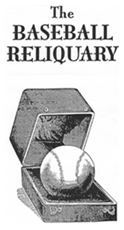 THE PEOPLE'S HALL OF FAME THE PEOPLE'S HALL OF FAME
The Hall of Fame once published a nifty map called "Baseball and America", which
showed, using stars and dots and little baseballs, all the baseball-relevant sites scattered
across this big country of ours. There you'd discover that Charlie Gehringer's birthplace
was in Fowlerville, Michigan; that over in Kansas City the Federal League Packers held
sway from 1914-1915; and that Ozark, Missouri has an independent league team called
the Mountain Ducks. Perhaps, most curious of all, in the enlarged section of the Los
Angeles area, you'd find a listing for a museum called "The Baseball Reliquary". Should
you fly into LAX, however, rent a rattling Kia (the cheapest car there is) and head on into
the suburb of Monrovia, you won't see any hint of a Reliquary. There are no signs
leading you down this exit or that avenue. Gas station attendants don't know where to
point you. Men washing their car give you funny looks when asking directions. Finally,
when you check the address in your pocket, you'll see that there isn't anything but a P.O.
Box. So what—and where—is The Baseball Reliquary?
According to its website, The Baseball Reliquary "is a nonprofit, educational institution
dedicated to fostering an appreciation of the historical development of baseball and its
interaction with American culture by the preservation and exhibition of artifacts related to
the National Pastime." But what first got our attention was this 'fostering artifact': a
fragment of skin from Abner Doubleday's inner thigh. Amazingly, this is not the
strangest item in their collection.
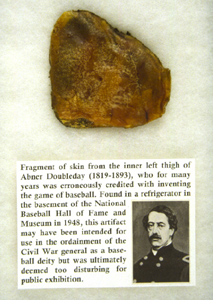 The Reliquary is the brainchild of Terry Cannon, its executive director, who runs it with
the support of his wife Mary and a Board of Directors, which includes Albert Kilchesty,
Archivist and Historian. "The skin fragment is a conduit for telling who Doubleday is,"
Terry explains. "Why he's important to the history of the game, who was he, and why
does he tie into the creation of the Hall of Fame in Cooperstown. One of our missions is
to bring fun and imagination back into the game. We want to keep alive the folklore and
the myths and the legends that have developed throughout the years and seem to be lost
on the current generation. Whether they're fact or fiction. It's not so much the statistics,
but the great stories. That's where baseball has it over every other sport." The Reliquary is the brainchild of Terry Cannon, its executive director, who runs it with
the support of his wife Mary and a Board of Directors, which includes Albert Kilchesty,
Archivist and Historian. "The skin fragment is a conduit for telling who Doubleday is,"
Terry explains. "Why he's important to the history of the game, who was he, and why
does he tie into the creation of the Hall of Fame in Cooperstown. One of our missions is
to bring fun and imagination back into the game. We want to keep alive the folklore and
the myths and the legends that have developed throughout the years and seem to be lost
on the current generation. Whether they're fact or fiction. It's not so much the statistics,
but the great stories. That's where baseball has it over every other sport."
And this is where The Reliquary has it over any other baseball museum. Among their
hundreds of crazy artifacts you'll find a melted 45 record from Bill Veeck's ill-conceived
"Disco Demolition Night"; Eddie Gaedel's jock strap; and a replica of the severed digit
of Three-Finger Brown (created by a family friend to display at a tourist attraction the
Brown family erected). Some of these might just give you nightmares. The Reliquary
has a number of traveling exhibits throughout the Southern California area, including a
replica of Ebbetts Field made predominately with cake supplies (by a man who had never
stepped foot in a baseball stadium). There's also a partially eaten hot dog excavated from
the belly of Babe Ruth, during his infamous "Bellyache Heard 'Round the World". That
last item was described by one writer as being displayed 'like a splinter from the cross'.
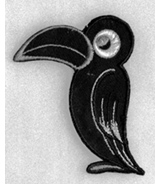 Some of the items are poignant. Our favorite is the Jim Crow patch, worn on the sleeves
of the New York Black Yankees and the New York Cubans during a game in Yankee
Stadium in 1942, to protest Jim Crow laws in baseball. Protesters at the game held
placards that read, "If We Can Stop Bullets, Why Not Balls?" The Reliquary places
these artifacts at "the service of the imagination," Albert argued in a recent keynote
addresses. "Or, to put it another way, uses the imagination to trigger the artifact." Such
is the case with the patch, which raises a variety of sad and disturbing questions. How
painful it must have been for these men and women, on the field and in the stands, to
have to watch segregated baseball in Yankee stadium while their friends and family
fought and died for democracy. How could baseball, billed since its inception as a
bastion of patriotism, keep these talented players out, and then field one-armed white
men? And yet it is also a testament to the power of baseball, for even as these men were
denied their proper place in the big leagues, they still played the sport they loved. Some of the items are poignant. Our favorite is the Jim Crow patch, worn on the sleeves
of the New York Black Yankees and the New York Cubans during a game in Yankee
Stadium in 1942, to protest Jim Crow laws in baseball. Protesters at the game held
placards that read, "If We Can Stop Bullets, Why Not Balls?" The Reliquary places
these artifacts at "the service of the imagination," Albert argued in a recent keynote
addresses. "Or, to put it another way, uses the imagination to trigger the artifact." Such
is the case with the patch, which raises a variety of sad and disturbing questions. How
painful it must have been for these men and women, on the field and in the stands, to
have to watch segregated baseball in Yankee stadium while their friends and family
fought and died for democracy. How could baseball, billed since its inception as a
bastion of patriotism, keep these talented players out, and then field one-armed white
men? And yet it is also a testament to the power of baseball, for even as these men were
denied their proper place in the big leagues, they still played the sport they loved.
Items like these are a refreshing contrast to the stodgy, middle-of-the-road Hall of Fame
in Cooperstown, NY. And many of The Reliquary's exhibits are hilarious as well as
intriguing. For instance, there's a tortilla bearing the likeness of former Dodger owner
Walter O'Malley. "No other item of baseball memorabilia illustrates more succinctly the
complex relationship between the Los Angeles Dodgers and their Mexican-American fan
base!" the website claims. Not only would the Hall retch at the thought of displaying
something so absurd, they also wouldn't dare examine the story of how the Dodgers
found themselves in L.A. and how they—and the city of Los Angeles—built a stadium in
Chavez Ravine, uprooting hundreds of families. Unlike Cooperstown, "The Reliquary is
a grass roots organization," Albert points out. "Started by fans, not by the baseball
establishment, not by corporations, not by interests that are there to make money, keeping
things as status quo as possible. We can rock the boat because we haven't got anything
to lose. We're poor."
And yet even the Reliquary is not without controversy. About three years ago, Albert
received a phone call from a friend who had just moved into a house in Ho-Ho-Kus, New
Jersey. The house used to belong to the widow of a retired New York City policeman,
whose beat just happened to include the Polo Grounds. Apparently, this was one of the
cops who rescued the Eddie Grant plaque from some hoodlums seeking to steal it after
the last Giants game in 1957. The plaque, for those unfamiliar with the tale, sat beneath
the towering Chesterfield Cigarette sign in the recesses of deep center field. It was a slab
of bronze that honored Eddie Grant, the New York Giants shortstop who was killed in
action during World War I in the Argonne Forest. The Reliquary negotiated a price for it
and shipped it west to add to their archives.
"Unfortunately," Albert says, "we had no idea that out in New York there was a group
whose sole purpose was to locate this thing. They were crushed and started accusing us
of faking it. But why would anyone forge a 75 pound bronze plaque?"
THE SHRINE OF THE ETERNALS
But The Reliquary isn't just a bizarre collection of artifacts—it's also the home of the
Shrine of the Eternals, a living monument to some of the great personalities of the noble
sport. Called "The People's Hall of Fame" by Jim Bouton, members of the Reliquary
(open to anyone wishing to join) vote to induct their favorite people into the Shrine.
Since 1999 there have been fifteen inductees, three per year. They include: catcher and
'atomic spy' Moe Berg, Jim Bouton, Dock Ellis, Mark Fidrych, Curt Flood, Shoeless Joe
Jackson, Bill Lee, Minnie Minoso, Satchel Paige, Jimmy Piersall, ground-breaking
female umpire Pam Postema, Bill Veeck, and, this year's inductees, one-handed pitcher
Jim Abbott, Ila Borders (the woman who pitched three seasons of men's minor league
baseball), and Marvin Miller.
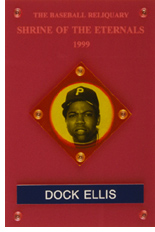 What makes up a candidate for the Shrine? As Dr. Robert Elias put it in this year's
keynote address: "The Reliquary's induction criteria stand in bold contrast to the mere
compilation of baseball statistics and records. They reward the distinctiveness of one's
play, uniqueness of one's character, and the person's imprint on the baseball landscape.
They reflect excellence in character or principle, and contributions to developing baseball
as an arena for the human imagination." Each spring, The Reliquary mails to its
members a list, with a short biography, of fifty possible candidates. This year's list
ranged from Dummy Hoy, deaf and mute centerfielder (made somewhat famous in an
essay by Stephen Jay Gould); to Effa Manley, owner of the Negro League Newark
Eagles; to Bill Buckner, Bill James, and Dave Kingman, among many others. In the past
they've had fictitious players like George Plimpton's Sidd Finch and James Thurber's
Pearl du Monville. At times, reading the brief biographies on the list is like discovering a
lost continent in the world of baseball. This is especially true in the case of people such
as Kenichi Zenimura, "the father of Japanese-American baseball" who organized
goodwill baseball tours in Japan just before World War II, and who almost single-
handedly brought baseball into the internment camps here at home, building bases from
bags of rice and foul lines from flour. As a member, you vote on your favorites. The
votes are tallied, the results announced, and then, in July (a date chosen 'coincidentally
on-purpose' at the same time as the official Hall of Fame inductions), the three inductees
are flown in for an amazing ceremony. What makes up a candidate for the Shrine? As Dr. Robert Elias put it in this year's
keynote address: "The Reliquary's induction criteria stand in bold contrast to the mere
compilation of baseball statistics and records. They reward the distinctiveness of one's
play, uniqueness of one's character, and the person's imprint on the baseball landscape.
They reflect excellence in character or principle, and contributions to developing baseball
as an arena for the human imagination." Each spring, The Reliquary mails to its
members a list, with a short biography, of fifty possible candidates. This year's list
ranged from Dummy Hoy, deaf and mute centerfielder (made somewhat famous in an
essay by Stephen Jay Gould); to Effa Manley, owner of the Negro League Newark
Eagles; to Bill Buckner, Bill James, and Dave Kingman, among many others. In the past
they've had fictitious players like George Plimpton's Sidd Finch and James Thurber's
Pearl du Monville. At times, reading the brief biographies on the list is like discovering a
lost continent in the world of baseball. This is especially true in the case of people such
as Kenichi Zenimura, "the father of Japanese-American baseball" who organized
goodwill baseball tours in Japan just before World War II, and who almost single-
handedly brought baseball into the internment camps here at home, building bases from
bags of rice and foul lines from flour. As a member, you vote on your favorites. The
votes are tallied, the results announced, and then, in July (a date chosen 'coincidentally
on-purpose' at the same time as the official Hall of Fame inductions), the three inductees
are flown in for an amazing ceremony.
For instance, in 1999 Dock Ellis said that the ceremony was the first time any group had
acknowledged him. He was moved to tears. Jim Bouton spoke about drafting players
from prisons. This year Marvin Miller was his usual feisty self, pointing out that baseball
people rely on clichés instead of facts. He went on to argue that in the first fifteen years
of the union, there was one stoppage during the regular season, amounting to nine days
lost in 1972. "That represents less than three tenths of one percent of the games played in
that time. And yet people believe that baseball is one of the most unstable workforces
there is." Would Miller make the same speech in Cooperstown if elected? "I haven't
thought about it yet," Miller says, laughing.
Needless to say, most of the characters inducted into the Shrine would never get into the
Hall of Fame, not in ten lifetimes. Aside from the fact that many, like Bouton and
Fidrych and Ellis, fall short statistically, there are those, like Miller and Shoeless Joe who
have the credentials but are not politically correct. "It seems to me," Miller said, "that
the fact that they had earlier inducted Jackson suggests a dissatisfaction barring a player
for off the field behavior. I have no idea of his guilt or innocence, but what you can draw
from it is a willingness of baseball officialdom to make its own condemnation of
individuals with no appropriate hearing or trial."
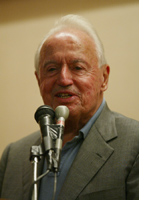 But the Reliquary isn't about being an opposite to anything, an anti-Cooperstown.
Rather, it is about giving the fans a voice. Ask yourself this question: what good does
it do for a fan to become a 'friend' of the Hall of Fame? Aside from discounts and the sterile
reading material, it doesn't amount to much. Fans have no say in what goes on, in who
will speak and who won't, in who gets inducted and who won't. Certainly ESPN will
have their own polls, allowing the fans to say "let Pete Rose in!", but that's about as
effective as driving to Cooperstown and shouting at its ivy-covered walls. But the Reliquary isn't about being an opposite to anything, an anti-Cooperstown.
Rather, it is about giving the fans a voice. Ask yourself this question: what good does
it do for a fan to become a 'friend' of the Hall of Fame? Aside from discounts and the sterile
reading material, it doesn't amount to much. Fans have no say in what goes on, in who
will speak and who won't, in who gets inducted and who won't. Certainly ESPN will
have their own polls, allowing the fans to say "let Pete Rose in!", but that's about as
effective as driving to Cooperstown and shouting at its ivy-covered walls.
The Reliquary is different. Joining allows you the privilege of voting your own favorites
in (though ours, Veeck and Fidrych, had already been inducted). The Board of Directors
takes suggestions on who can be amongst the fifty candidates and there's no limitations
as to who belongs. For fans whose bile starts churning every time the Hall disses Ron
Santo or Jim Rice, why not join The Reliquary and speak out? We'd love to see colorful
plaques for Sadaharu Oh and Emmett L. Ashford (the first African-American umpire in
the big leagues) hanging in the Shrine. Can you get this pleasure at Cooperstown? Is
there any exhibit there that'll make you laugh and ponder like the Babe Ruth hot dog?
As far as the 'where' is concerned, The Reliquary is without a home, which is just fine
with its founders. Although someday they would like to see the organization settle down
into a permanent location, they don't want it to overwhelm their goals. Like the
barnstorming teams of the early 20th Century, The Reliquary hangs its hat where people
love baseball. As with these traveling teams, the Reliquarians want to bring the game
back to the fans. "It comes down to a matter of belief," Albert says. "There's magic in all
of these artifacts and accoutrements of baseball. If you believe in the game and its power
to engage and shape the world, then you believe in The Reliquary."
Special thanks to Larry Goren for use of his photos.
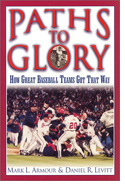 DYNASTY BUILDING 101 DYNASTY BUILDING 101
Review by Stew Thornley
Daniel R. Levitt, a Minneapolis baseball researcher, and Mark L. Armour, an
Oregon resident, team up on an fascinating project—how significant teams have
been built and how they have been dismantled, in their new book Paths to Glory: How Great Baseball Teams Got That Way (Brassey's, $27.95). While
many books profile some of the great teams of all-time, this book takes it from a
different angle.
Armour and Levitt mix interesting narrative, especially profiles of the builders of
the teams, with statistical analysis. While the two are serious statistical analysts,
their insights do not go over the heads of those who pay attention only to the
most basic numbers. Their explanation of some of their stats, such as "wins
above replacement" and "win probability added," are provided in simple terms, so
the book can be enjoyed and understood by a wide range of fans.
The authors profile 13 teams—from the 1899 Brooklyn Superbas to the Atlanta
Braves of the 1990s—and include a chapter that will greatly interest Minnesota
fans, a close look at the Twins of the 1960s. This features a brief biography of
owner Calvin Griffith and history of the team that extends back to prior to their
move to Minnesota. The Twins came close to another pennant in 1967 and had a
pair of first-place finishes in the new American League West starting in 1969,
although they were clearly an inferior team to the East Division champion Orioles
(and were swept in the playoffs each year by Baltimore), meaning that they never
did follow-up on their 1965 magic. Armour and Levitt offer cogent reasons for
their decline.
I particularly enjoyed the look at the owners and general managers, and the
authors' description of the tyranny of Athletics owner Charles O. Finley is
marvelous. A lengthy look of the White Sox of the 1910s focuses not on the
Black Sox who intentionally lost the 1919 World Series but on how the team that
won the 1917 World Series was built. In the process, Armour and Levitt deal with
the common perception that the players who conspired to throw the 1919 series
were driven to it by the penuriousness of team owner Charles Comiskey.
"Comiskey had his faults," the authors conclude, "but in comparing the salaries of
his White Sox to the rest of baseball, the evidence suggests that he paid no less
than his peers."
I attended a book signing and reading featuring Levitt, who is witty and articulate.
After his talk, I overheard him say that he hopes people don't find any typos in
the book, but he looks forward to arguing with those who differ in their analysis.
I'm afraid I may be the opposite of what he is looking for. I can't argue with much
that they have written, and, unfortunately, I did find a few typos. One is a
misspelling of Larry MacPhail's name in Rob Neyer's foreword (it's incorrectly
spelled "McPhail"). The other comes in one of two extremely insightful chapters
on the changing role of relief pitchers. On page 93, the authors state that in 1975
the save rule was liberalized to the one in use today, which requires a reliever,
among other things, to protect a three-run lead for at least one inning or face the
potential tying or lead run. Actually, a pitcher is eligible for a save if he enters the
game with the tying run on deck. This error does not detract from a great analysis
of the save rule and how it changed through the years. The rule was more
restrictive in 1974, to the point that "had this rule applied to Dennis Eckersley's
1992 season, in which he saved fifty-one games, Eckersley would have instead
have been credited with only twelve saves." (By the way, using Retrosheet, I
went through the 1992 season and confirmed Armour and Levitt's assertion
regarding Eckersley and how many saves he would have had under 1994
scoring rules.)
A later chapter in the book follows up with a comparison of the "Fireman vs. the
Closer," looking at the differences when relievers were brought into the game to
put out a fire and today's closers, who are normally brought into the game at the
start of the ninth inning to protect a lead of up to three runs.
In a way, these sections seem out of place with the ones that follow the primary
premise of the book, how teams are built. However, they are enjoyable and cover
a variety of topics, such as patterns in aging with regard to players' declines.
Most of all, Paths to Glory is a well-written, fresh look at a topic not explored in any
extensive manner before, and it is a valuable addition to baseball knowledge and
research.
LIES, DAMNED LIES, AND STATISTICS
The sabermetric approach to studying baseball has always been a bit suspect in the minds
of established baseball men, at first seeming like nothing more than a hobby by
overzealous fans, and lately, with the advent of Moneyball (among others), an
alarming turn to the heretical, a destructive force that is draining baseball of its life. All
of us have heard the arguments: the outright denial of certain discoveries (that the
sacrifice bunt is a virtually worthless strategy) to appeals for a return to the so-called
good ol' days (which, in our minds, has some credibility, if only from an aesthetic
standpoint). But the arguments have suddenly become serious. Now sabermetrics is
racist.
It probably goes without saying that, at some point, sabermetrics, and Bill James in
particular, was going to find itself caught in the quagmire of the debate over racism. In a
column by ESPN's Rob Neyer, he points out that Ralph Wiley (also of ESPN) and
Richard Griffin (of the Toronto Star) have argued that sabermetrics is subtly racist.
According to the latter, "new-wavers [like Billy Beane and J.P. Ricciardi] believe in
building offence through patience at the plate and taking no chances on the bases. That's
a pre-WWII style of play. Under those criteria, Jackie Robinson could not have played in
the majors." Wiley, on the other hand, argues that Bill James pooh-poohs basestealing,
which Wiley believes is the great offensive weapon of the African-American player. He
goes on to state that "any time a baseball manager will give up an out for a base, as with a
sac bunt or groundball to the right side, any time a base is so precious, then it goes
without saying that the stolen base must be important". Wiley then suggests that players
like Rickey Henderson become 'bad guys' because of this.
Neyer counters that sabermetrics is being used as a scapegoat, which is partially true.
However, he muddles the issue by tackling it directly. Neyer points out that Bill James actually believes that Rickey
Henderson is just peachy; why, he wrote a number of pieces in praise of Henderson.
This misses the essence of Wiley's point. First of all, our
experience tells us that it's the sacrifice bunt, not the stolen base, that most
Sabermetricians disdain most. Nonetheless, one of the controversies in Moneyball regards
the As dislike of the stolen base. Should this model spread throughout the league, would
men like Rickey Henderson dry up? Would this style of play discourage African-
Americans, which is something to worry about. If so, should black kids learn new
tools? Is that racist question? Of course, that also begs one to wonder whether or not the stolen base is
predominantly a tool of the African-American player in general, and not just famous
black players. Is that a stereotype? Sadly, Wiley doesn't even begin to try and prove any of this, choosing
instead to aim his pen at Bill James with less-than-mediocre results.
Griffin's point, on the other hand, is a bit more touchy. Neyer argues that Toronto would
have loved Jackie Robinson because his OPB was so high. And yet, this isn't an entirely
fair response. For in Moneyball we discover that the As (and now the Red Sox and Blue
Jays) considers it an especially bad decision to take a high school prospect, largely due to
the fact that the stats in high school are not as accurate a reflection of baseball talent as in
college. Using this criterion—and it's reiterated throughout that book—I think that
Griffin is right in suggesting that the As today would have shied away from men like Robinson, and all the Negro
Leaguers, who came from leagues with lousy scorekeeping and poor competition. After all, the OBP
they claim to love in Jackie Robinson is from his professional career, after he was signed. Not
before.
The problem is that this is the age old missing-the-forest-for-the-trees, something the
detractors of the so-called Beane model keep doing, over and over. The fact is that the
As pay so much attention to statistics because they have to, and shun high schoolers
because they have to. They discount defense because they understand that offense is
more important… not that defense is bad (something that many of their critics fail to
understand). Had this model existed in the 40s, had there been such a disparity between
the payrolls, if we could believe that Beane would have had the foresight and the courage
(and the latter, at that time, was more important than the former), then the As would not
have looked at statistics as they do today, but instead signed the players in the Negro
Leagues, which fit their model: great talent, dirt cheap. The sabermetrics used today
only help them to sign players everyone else sees (quite literally) as not up to snuff.
While it's true that African-Americans are certainly vanishing from baseball, there seems
to be little evidence that the statistics are keeping them out. And yet, it never hurts to
question any new way of thinking; that's part of what sabermetrics is all about. Wiley, of
course, doesn't give a shred of evidence that there are piles of young black talent waiting
in the minors, discouraged because their OBP is low and their stolen bases are high. Nor
could he argue that these children are turning to basketball because Bill James lurks like a
bogeyman on the mound. The saddest part of this debate is not that something so 'pure'
as sabermetrics is being accused of racism; rather, it's that its accusers have done a poor
job of proving anything.
READINGS
Speaking of Neyer, his July 23rd column contains sort-of an error. Practically begging
the Royals to make some moves, he points out that "The Royals have now scored exactly
as many runs as they've allowed, and while goofy-brained fans can talk about "chemistry"
and "knowing how to win" until the cows and the sheep come home, ITAL you don't win
pennants if you don't outscore your opponents.ITAL" The italics are his. While it's true
that no team has won a pennant that has been outscored by its opponents, one team HAS
won its division, and another was en route to that goal had a player's strike not shut
everything down. The '97 Giants were outscored 793-784, and the '94 Rangers were
offensively bested 697-613. Christ, the Rangers could have WON their division that year
with a losing record (they finished 52-62). We bring this up because, in this age of tiny
divisions, the old rules might not apply. As we all know, once you make it into the
playoffs, the underdogs can have their day, whether or not they outscored anyone over
the season. In fact, someday a team will win its division with a losing record and if that
happens, it could stands to reason that this club could just scrape through the playoffs to
the Series. In a division as weak as the Central, it is not out of the question that the
Royals—without any significant changes—could take the title… TwinsGeek
continues to amaze, this time with a great piece on umpiring (originally written for the
Timberwolves), in which he compares the arbitrators with lab rats. Sadly, it sometimes
seems as if Minnesota fans are the rats, quietly waiting their cues to clap, cheer, and say
"Root, root, root for the HOME TEAM". And the Geek is not afraid to show his shady
side, chowing down on grilled meatstuffs at the expense of Wells Fargo. Viva the
Geek!…In the newest Elysian Fields Quarterly, Eric Enders, former Hall of
Fame employee and citizen of Cooperstown, gives us the inside scoop of the Dale
Petroskey/Bull Durham affair, and it's not a pretty sight (nor is the Hall's increasingly
partisan slant)… as we stated last issue, the Twins, 6 1/2 down at this writing, are now
much more fascinating to watch. Will they or won't they make another trade? And
aren't these coming games against the Tigers and Indians and Orioles that much more
fascinating, huh? If you've got ulcers there's other stress in your life, pal, so just sit
back, have a few Tums with that beer, and enjoy the rest of the season...

|



